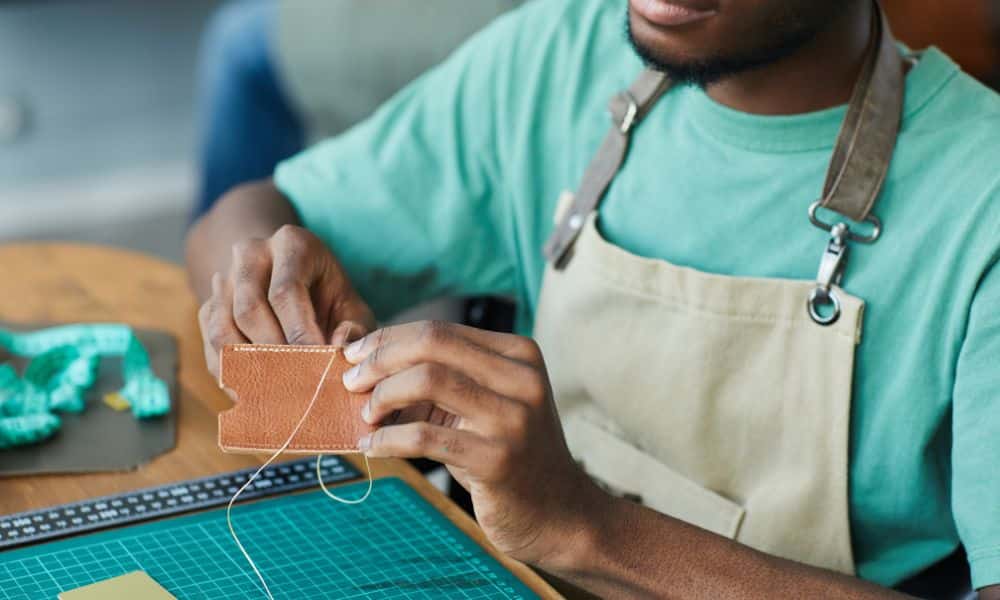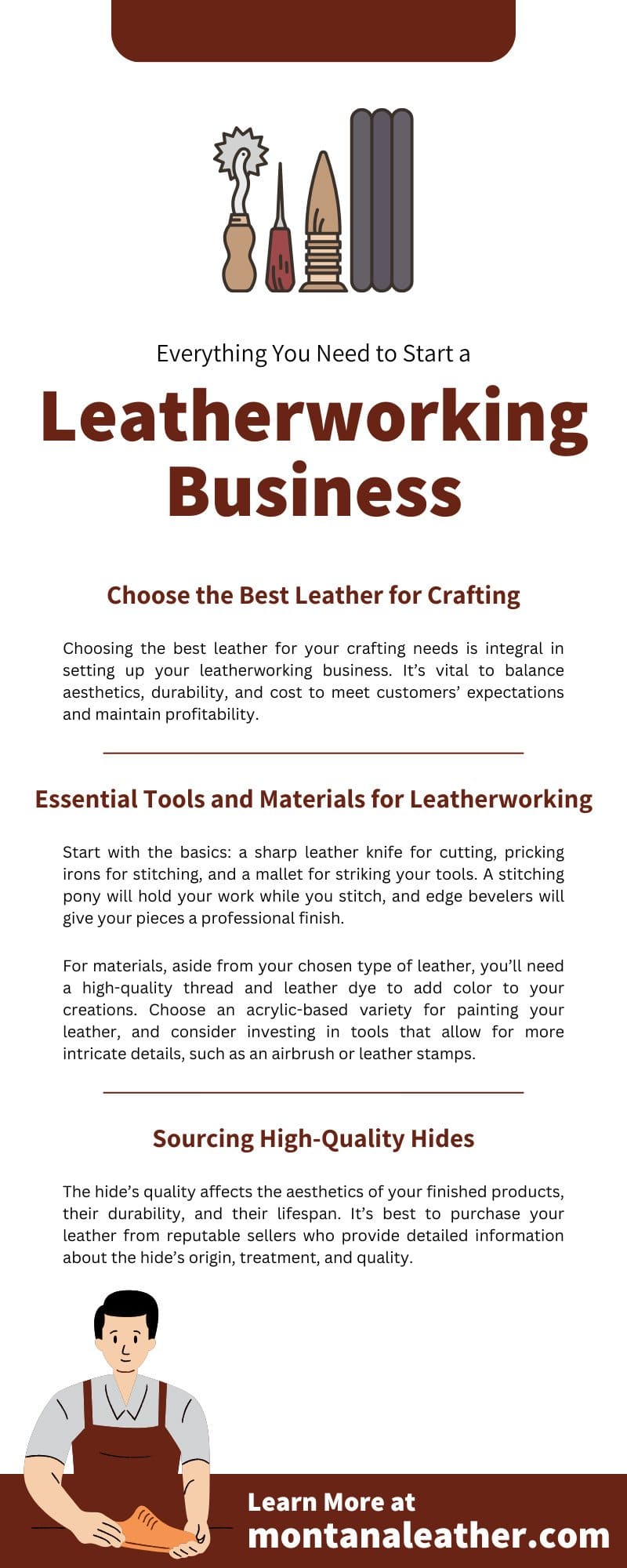
Embarking on a leatherworking business is an exciting and lucrative venture. Harnessing the timeless appeal and durability of leather helps you create a wide array of products, but you’ll need to tackle a few tasks before you begin. Use this list of everything you need to start a leatherworking business and get started on the path toward enhancing your craft and making a profit.
Define the Goals of Your Leather Business
Before you start production, it’s crucial to define your goals for your leatherworking business. Consider what you want to achieve both in the short and long term. When you intend to create a local boutique brand focused on custom creations, consider how you’ll grow in popularity and what level of notoriety you want to achieve.
If you aspire to scale up and distribute your products nationally or internationally, set a goal for the number of sales you wish to achieve in a certain quarter. Whatever your intentions, setting clear, realistic goals provides a roadmap for your business, driving your decision-making and shaping your strategic planning.
Understand the Options for Leather
Before diving into the world of leather crafting, it’s essential to understand the different types of leather available. Each type holds unique characteristics and serves specific functions.
Cowhide, for example, provides robustness and versatility, making it an excellent choice for various products, from wallets and belts to furniture and car interiors. Cowhide’s durability ensures that products made from it will stand the test of time, while its smooth surface provides an attractive finish. Moreover, you can easily find ethically and sustainably sourced cowhide that aligns with modern consumers’ expectations.
Understanding leather is important for running a successful leather business, and utilizing each beneficial feature of each leather type ensures you make the best products for customers. By choosing the right leather, you align your business with quality and longevity, projecting an image of reliability and craftsmanship to your audience.
Choose the Best Leather for Crafting
Choosing the best leather for your crafting needs is integral in setting up your leatherworking business. It’s vital to balance aesthetics, durability, and cost to meet customers’ expectations and maintain profitability.
For novice leatherworkers, vegetable-tanned cowhide leather is often a good starting point due to its rigidity and ease of tooling. It’s an excellent choice for belts, wallets, and other small accessories.
For more luxurious items such as bags or jackets, full-grain leather provides a high-quality, durable finish that ages beautifully. Understanding the properties of different leather types helps you make informed decisions and select the best material for each unique project.
Essential Tools and Materials for Leatherworking
When you run a leatherworking business, you need various essential tools and materials. Start with the basics: a sharp leather knife for cutting, pricking irons for stitching, and a mallet for striking your tools. A stitching pony will hold your work while you stitch, and edge bevelers will give your pieces a professional finish.
For materials, aside from your chosen type of leather, you’ll need a high-quality thread and leather dye to add color to your creations. Choose an acrylic-based variety for painting your leather, and consider investing in tools that allow for more intricate details, such as an airbrush or leather stamps.
Remember, the quality of your tools and materials can significantly impact the quality of your finished products, so it’s worth investing in the best you can afford. Equip yourself with these tools, and you will be well on your way to creating beautiful, handcrafted leather goods.
Sourcing High-Quality Hides
The hide’s quality affects the aesthetics of your finished products, their durability, and their lifespan. It’s best to purchase your leather from reputable sellers who provide detailed information about the hide’s origin, treatment, and quality.
The best hides are often ethically sourced and tanned, ensuring that they are both high-quality and sustainable. Make sure you have as much information as possible about where you source your hides from to ensure quality when buying leather in bulk.
Key Leatherworking Skills To Develop
Developing key skills in leatherworking is a vital component of building a successful business in this industry. Mastering techniques such as cutting, stitching, and dyeing requires practice, patience, and precision. Understand how to manipulate leather to achieve the desired effect, whether you’re creating a sleek, modern handbag or a vintage, distressed wallet.
With time and dedication, these skills are within your reach. Consider attending leatherworking workshops or online tutorials to speed up your learning process.
Learn How To Create Unique Leather Products
Creating unique leather products is an art that requires creativity, craftsmanship, and a deep understanding of the material. This journey begins with selecting distinctive patterns and designs that align with your brand’s aesthetic and your customer preferences. Consider integrating aspects of current fashion trends while maintaining a timeless appeal.
Experiment with different styles, textures, and finishes to create a wide array of products that highlight the versatility of leather. Remember, uniqueness lies in the details, so pay attention to elements such as stitching, embossing, and hardware.
Establishing Your Brand in the Leatherworking Industry
Establishing a strong and distinctive brand in the leatherworking industry is paramount to your success. Begin by identifying your unique selling propositions. These factors might be your commitment to sustainability, your innovative designs, or the exceptional quality of your craftsmanship.
Once you have defined these unique offerings, build your brand around them. Create a compelling brand story that resonates with your target audience and accurately reflects your values and vision.
This narrative forms the backbone of your marketing efforts, helping build a community around your brand and fostering customer loyalty. You’ll carve out your niche in the leatherworking industry through consistent, authentic, and engaging branding.
Establish a Customer Base
Establishing a solid customer base is a critical step in growing your business. Start by identifying your ideal customer—understanding their preferences, needs, and lifestyle helps you effectively tailor your products and marketing strategies. Building relationships through excellent customer service and engaging communication can foster customer loyalty, turning first-time buyers into repeat customers.
Tap into online platforms and social media to reach a wider audience. Offering personalized products or services further endears you to your customers, making your brand their go-to choice for leather goods.
Set Up Ideal Conditions for Leatherworking
Create a dedicated workspace that is clean, well-ventilated, and adequately lit to ensure precision in your crafting. Keep your tools organized for easy access and to maintain their condition.
Control the humidity and temperature in your workspace to prevent the leather from drying out or becoming too damp. A well-set-up workspace makes your leatherworking process more efficient and shows your professionalism and commitment to creating quality leather goods.
Your dive into the leather industry is a journey filled with creativity, craftsmanship, and rewarding opportunities. With the right knowledge, tools, and dedication, you can transform your passion for leather into a successful venture. Take the first step and start your leatherworking business with everything you need to turn dreams into reality.


